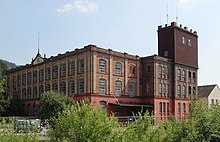Wiesentäler Textile Museum
The Wiesentäler Textile Museum is a museum in the town of Zell im Wiesental in the southern Black Forest . It is housed in the shed roof halls of a former weaving mill on the banks of the Wiese River .
history
The museum was brought into being in 1996 with a basic collection based on the exhibition “Between School and Factory, Textile Women’s Work in Baden” of the Baden State Museum , which was shown in Karlsruhe, Berlin and Zell in 1993/94. After the initiator's death, the collection was forgotten for a few years. A support association founded in 2003, which is the sponsor of the museum, achieved an expansion of the building to over 1000 square meters after renovation and alterations, so that the museum could be reopened in 2009.
Background: Textile industry in the Wiesental
The museum deals with the textile manufacturing branch that dominated the Wiesental between Basel and Todtnau from the early 19th century until its decline in the second half of the 20th century. The focus is on the representation of the textile industry , shaped among other things by families of manufacturers from Switzerland and Alsace :
- The Zeller Vogt Meinrad Montfort brought a small weaving colony from the Fugger city of Augsburg in the 18th century, when Zell was still part of the Austrian frontier (this is also where the connection between the famous Weber family of musicians and Zell comes from: Franz Fridolin Weber ; Constanze Mozart , née Weber; Aloisia Lange , née Weber). Montfort let spinning and weaving work from home for Basel entrepreneurs and set up a bleaching facility in Zell; he is considered the founder of the Zell textile trade
- After the devastating fire in Zell in 1818, Peter Koechlin from Mulhouse in Alsace , known as the "King of Printing Materials", had the first hand-weaving mill built in Zell in 1837 (see also the KBC in Lörrach , which still exists today )
- Other families of textile manufacturers active in the Wiesental were Sarasin, Bölger, Iselin, Merian, Mez, Ringwald and more
The use of the hydropower of the Wiese river, the accession of the state of Baden to the German Customs Union (1834/35) and the Zell-Todtnau railway line opened in 1889 (see Wiesentalbahn ) led to strong industrial development in the valley. A large part of the working population of the Wiesental, including a high proportion of women, has since made a living from the textile industry, in its heyday over 20,000 people.
Stock and presentation
The permanent exhibition of the museum, which is only open in the summer half-year, shows various techniques of textile production, from the processing of cotton fibers to spinning, winding, warping and sizing up to weaving, bleaching and dyeing. The time spectrum ranges from textile home work to the first manufactories to work in the textile factories.
The focus of the exhibition is industrial production. Among other things, mechanical weaving machines, spinning and winding machines, string braiding machines with which cords are made, dyeing machines as well as testing and measuring devices for testing cotton quality will be presented. The Wiesentäler Textile Museum sees itself as a "living museum", because all processes can be demonstrated practically on operational machines. At jacquard weaving machines, for example, demonstrated how images and woven weave pattern emerge or what a Patroneur made.
The most important textile factory in Zell after the Second World War was the internationally active spinning and weaving mills Zell-Schönau AG (table and bed linen brand “Irisette”) with more than 1,500 employees and around 360 looms. Your company history is presented in the entrance room.
The home work department shows a sewing school, as it was typical in Wiesental, many sewing machines and original products of textile handicraft techniques such as artificial knitting, crocheting, embroidery, knitting, sewing and lace making. A sub-area shows fabrics, sample drawings and the associated cartridges.
In addition, the historical development is illustrated by numerous photos from the early days of photography to the present day. School films can be shown in a video room.
literature
- Brigitte Heck: Between school and factory - textile women's work in Baden in the 19th and 20th centuries. (Exhibition by the Badisches Landesmuseum Karlsruhe and the Museum für Volkskunde, Staatliche Museen zu Berlin, Prussischer Kulturbesitz; February 27 to June 6, 1993, Karlsruhe, Schloß; November 6, 1993 to March 6, 1994, Berlin, Museum für Volkskunde). Thorbecke-Verlag, Sigmaringen 1993, ISBN 3-7995-0300-5 .
- Hans Fräulin: The Wiesentäler Textile Museum. In: Das Markgräflerland Volume 1/1997, pp. 157–161 digitized version of the Freiburg University Library
Web links
- Website of the Wiesentäler Textile Museum
- It all started with the white gold , Badische Zeitung , May 29, 2009
- Reminder of the textile industry , Badische Zeitung, May 1, 2009
Coordinates: 47 ° 42 ′ 25.2 ″ N , 7 ° 51 ′ 21.6 ″ E

